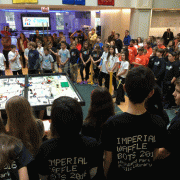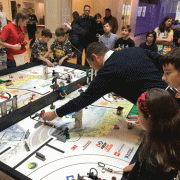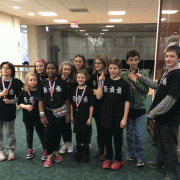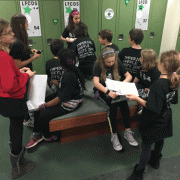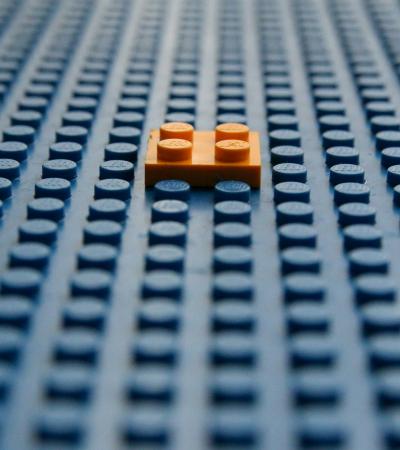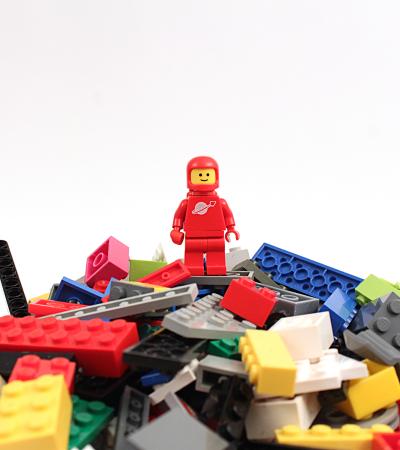The Highland Park Public Library envisioned forming one robotics team that would meet weekly to participate in the FIRST LEGO League (FLL). FLL is a robotics program that gives elementary and middle-school students the opportunity to work and create together to solve a common problem using robots and research.
Advanced Planning
Our goal was to yield an environment where participants would regard the librarians running the program (a.k.a. the coaches) as peers who value knowledge and expertise. In this way, relationships between team members and coaches would differ from the traditional student-teacher relationship by being less authority-driven and more support-oriented.
One of the major components in FLL is teamwork. We incorporate various teambuilding games so kids can learn to work with each other in a problem-solving capacity outside of robotics.
We make it a point to have team members set their own goals and agree amongst themselves on the expectations for the team. We help them visualize their expectations by asking them to create a timeline. Reviewing the status of this timeline over the course of the season conveys the importance of teamwork and reinforces the concepts of time management and prioritizing. Both timeline and expectations inevitably change over the season.
To the best of our abilities, we try guiding the team toward making decisions using the engineering design process as a model. We encourage the team to discuss, chart, analyze and review ideas. As coaches, it is our job to make sure that all ideas are heard and discussed.
Marketing
In the months leading up to the beginning of the program our library hosted several one-off robotics programs. At each of these programs we spread the word that the library would be forming a robotics team beginning in August and encouraged kids to consider participating.
The library also connected with the local high school’s robotics team, who, in turn, shared the news of a library-sponsored team within their social circles. Notices about a library-sponsored robotics team were also included in the library's monthly newsletter and social media outlets.
Budgeting
Costs for fielding a FLL team vary depending on what level of participation. There are never any “per student” fees; all costs for individual team members are assumed by the team as a group. New teams can expect to pay approximately $900 for team registration, a robot kit of parts and a challenge set.
Additional costs for event participation — travel, food, team shirts and other optional items — will vary. Veteran teams will pay less since the robot set can be used year after year.
Team registration must be purchased every season. FIRST offers many fundraising ideas, and teams are encouraged to create their own. Grants are also available, as well as sponsorships provided locally, regionally and nationally by many corporations.
The Highland Park Community Foundation generously supported our robotics programs through additional funding for LEGO Mindstorms kits. The Friends of Highland Park Library supported our robotics programs through additional funding for iPads. The support of these groups has been fundamental to the success of the library’s robotics programs.
Day-of-event Activity
Two staff members were required to sustain this program. From August through January there were a total of 15 practices lasting two hours each. Thirty minutes before and after each practice were needed for program set-up and tear-down.
Set-up duties included retrieving and preparing a large game board (equivalent to the size of a ping-pong table), two laptops, several containers of LEGOs, two LEGO EV3 robots, four tables and twelve chairs.
Program Execution
A major challenge we encountered along the way was leading the kids toward learning as opposed to giving out answers. For example, the kids found it difficult to build a drive system for the robot that would travel in a straight line. Concepts of torque and rolling versus slipping needed to be taught rather than just telling the team how to fix the problem. For the kids to understand these concepts, we needed to explain with language everyone could understand.
Another challenge was maintaining a constructive versus a destructive atmosphere. Any criticism about a design or program needed to be formed in a positive manner to avoid hurt feelings and stifle creative ideas. Getting the kids to refrain from putting down ideas different from their own was a constant activity. The kids had the mindset of their idea being the best without giving much consent to alternative solutions.
Advice
We have had great success with FLL robotics, but it does entail some tough choices. Team sizes are limited by the league, and a serious time commitment is required from both participants and library staff.
Exclusive focus on individual outcomes, skills, knowledge and development fails to illuminate what is most central and effective about the social and collaborative nature of FLL robotics.
Seek support from auxiliary organizations such as your Public Library Friends or Public Community Foundations, and look for opportunities to collaborate with local schools. Upon hearing that our library had a robotics team, the local school district invited our team to participate in their robotics tournament, and a new partnership was formed.
In addition, seek help from parents. Many parents are intrigued by robotics and are willing and happy to participate in practices with their kids. Computer programming is only one, relatively small part of First LEGO League robotics. Our robotics teams have benefited greatly from parents volunteering their time who have virtually no programming experience at all.


